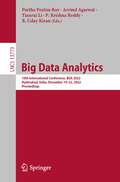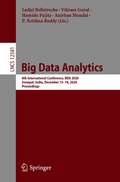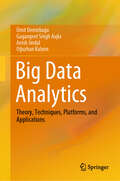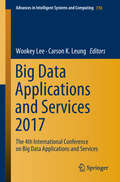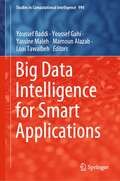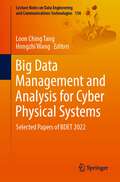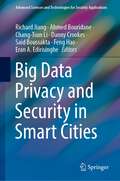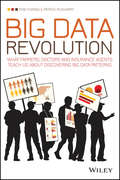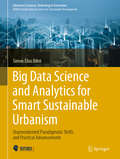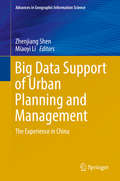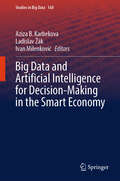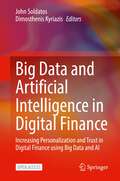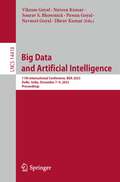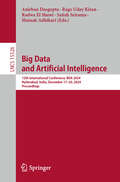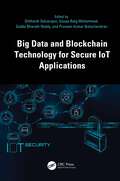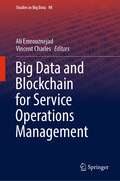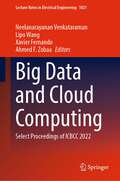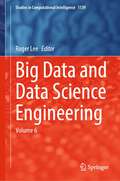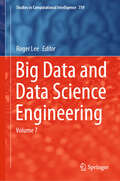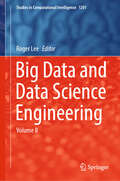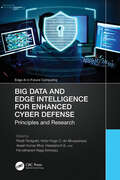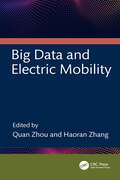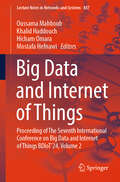- Table View
- List View
Big Data Analytics: 10th International Conference, BDA 2022, Hyderabad, India, December 19–22, 2022, Proceedings (Lecture Notes in Computer Science #13773)
by Arvind Agarwal Tianrui Li Partha Pratim Roy P. Krishna Reddy R. Uday KiranThis book constitutes the proceedings of the 10th International Conference on Big Data Analytics, BDA 2022, which took place in Hyderabad, India, in December 2022.The 7 full papers and 7 short papers presented in this volume were carefully reviewed and selected from 36 submissions. The book also contains 4 keynote talks in full-paper length. The papers are organized in the following topical sections: Big Data Analytics: Vision and Perspectives; Data Science: Architectures; Data Science: Applications; Graph Analytics; Pattern Mining; Predictive Analytics in Agriculture.
Big Data Analytics: 8th International Conference, BDA 2020, Sonepat, India, December 15–18, 2020, Proceedings (Lecture Notes in Computer Science #12581)
by Ladjel Bellatreche Hamido Fujita P. Krishna Reddy Anirban Mondal Vikram GoyalThis book constitutes the proceedings of the 8th International Conference on Big Data Analytics, BDA 2020, which took place during December 15-18, 2020, in Sonepat, India. The 11 full and 3 short papers included in this volume were carefully reviewed and selected from 48 submissions; the book also contains 4 invited and 3 tutorial papers. The contributions were organized in topical sections named as follows: data science systems; data science architectures; big data analytics in healthcare; information interchange of Web data resources; and business analytics.
Big Data Analytics: Theory, Techniques, Platforms, and Applications
by Gagangeet Singh Aujla Anish Jindal Ümit Demirbaga Oğuzhan KalyonThis book introduces readers to big data analytics. It covers the background to and the concepts of big data, big data analytics, and cloud computing, along with the process of setting up, configuring, and getting familiar with the big data analytics working environments in the first two chapters. The third chapter provides comprehensive information on big data processing systems - from installing these systems to implementing real-world data applications, along with the necessary codes. The next chapter dives into the details of big data storage technologies, including their types, essentiality, durability, and availability, and reveals their differences in their properties. The fifth and sixth chapters guide the reader through understanding, configuring, and performing the monitoring and debugging of big data systems and present the available commercial and open-source tools for this purpose. Chapter seven gives information about a trending machine learning, Bayesian network: a probabilistic graphical model, by presenting a real-world probabilistic application to understand causal, complex, and hidden relationships for diagnosis and forecasting in a scalable manner for big data. Special sections throughout the eighth chapter present different case studies and applications to help the readers to develop their big data analytics skills using various big data analytics frameworks.The book will be of interest to business executives and IT managers as well as university students and their course leaders, in fact all those who want to get involved in the big data world.
Big Data Applications and Services 2017: The 4th International Conference on Big Data Applications and Services (Advances in Intelligent Systems and Computing #770)
by Wookey Lee Carson K. LeungThis proceedings volume contains selected papers from the Fourth International Conference on Big Data Applications and Services (BigDAS 2017), held in Tashkent, Uzbekistan on August 15-18, 2017. Big data has become a core technology providing innovative solutions in many fields including social media, healthcare and manufacturing. The Fourth International Conference on Big Data Applications and Services (BigDAS 2017) presented innovative results, encouraged academic and industrial interaction, and promoted collaborative research in the field of big data worldwide. The conference was organized by the Korea Big Data Services Society and National University of Uzbekistan.
Big Data Approach to Firm Level Innovation in Manufacturing: Industrial Economics (SpringerBriefs in Applied Sciences and Technology)
by Aydin Azizi Seyed Mehrshad Parvin HosseiniThis book discusses utilizing Big Data and Machine Learning approaches in investigating five aspects of firm level innovation in manufacturing; (1) factors that determine the decision to innovate (2) the extent of innovation (3) characteristics of an innovating firm (4) types of innovation undertaken and (5) the factors that drive and enable different types of innovation. A conceptual model and a cost-benefit framework were developed to explain a firm’s decision to innovate. To empirically demonstrate these aspects, Big data and machine learning approaches were introduced in the form of a case study. The result of Big data analysis as an inferior method to analyse innovation data was also compared with the results of conventional statistical methods. The implications of the findings of the study for increasing the pace of innovation are also discussed.
Big Data Intelligence for Smart Applications (Studies in Computational Intelligence #994)
by Yassine Maleh Mamoun Alazab Youssef Baddi Loai Tawalbeh Youssef GahiToday, the use of machine intelligence, expert systems, and analytical technologies combined with Big Data is the natural evolution of both disciplines. As a result, there is a pressing need for new and innovative algorithms to help us find effective and practical solutions for smart applications such as smart cities, IoT, healthcare, and cybersecurity.This book presents the latest advances in big data intelligence for smart applications. It explores several problems and their solutions regarding computational intelligence and big data for smart applications. It also discusses new models, practical solutions,and technological advances related to developing and transforming cities through machine intelligence and big data models and techniques. This book is helpful for students and researchers as well as practitioners.
Big Data Management and Analysis for Cyber Physical Systems: Selected Papers of BDET 2022 (Lecture Notes on Data Engineering and Communications Technologies #150)
by Hongzhi Wang Loon Ching TangThis book consists of selected and peer-reviewed papers presented at 2022 4th International Conference on Big Data Engineering and Technology (BDET), held during April 22–24, 2022, in Singapore. As IT infrastructure and data management technologies have become critical assets and capabilities for today’s enterprises, this book aims to be part of the effort in contributing to their development. In particular, the BDET conference series aims to provide the much needed forum for researchers and practitioners across the world who are actively engaged in advancing research and raising awareness of the many challenges in the diverse field of big data engineering and technology to share their research outcomes and bounce ideas off their international colleagues. Over the last few years, the conference series has brought together the latest developments of novel theory in big data, algorithm and applications, emerging standards for big data, big data infrastructure, MapReduce and cloud computing, big data visualization, big data curation and management, big data semantics, scientific discovery and intelligence, which collectively form parts of the cyber-physical systems of interest. It is hoped that the book will prove useful to students, researchers, and professionals working in the field of big data engineering and applications in cyber-physical systems.
Big Data Management and Analytics: Concepts, Tools, and Applications
by Rajesh Jugulum David J. Fogarty Chris Heien Surya PutchalaAs more companies go digital and conduct their business online, this book provides practical examples of how they can better manage their data and use it to generate maximum value. It offers an integrated approach by treating data as an asset and discusses how to preserve and protect it just like any other corporate asset.Big Data Management and Analytics: Concepts, Tools, and Applications illustrates effective strategies for managing, governing, and analyzing big data to gain a competitive edge for companies utilizing big data and analytics. It offers a comprehensive guide on methods, tools, and concepts to efficiently manage and analyze big data in order to make informed decisions. Additionally, this book explores the significance of artificial intelligence and machine learning in leveraging big data and how they can be optimized in a well-structured environment. This book also emphasizes treating big data as a valuable asset and outlines strategies for preserving and safeguarding it like any other corporate asset. The inclusion of case studies ensures that the methodologies and concepts presented can be easily implemented in day-to-day operations.Given the current significance of big data in the business world, this book equips readers with the necessary skills to effectively manage this valuable asset. It is tailored for practitioners, students, and professionals working in data mining, big data, and machine learning across various industries, including manufacturing.
Big Data Privacy and Security in Smart Cities (Advanced Sciences and Technologies for Security Applications)
by Ahmed Bouridane Richard Jiang Danny Crookes Chang-Tsun Li Feng Hao Said Boussakta Eran A. EdirisingheThis book highlights recent advances in smart cities technologies, with a focus on new technologies such as biometrics, blockchains, data encryption, data mining, machine learning, deep learning, cloud security, and mobile security. During the past five years, digital cities have been emerging as a technology reality that will come to dominate the usual life of people, in either developed or developing countries. Particularly, with big data issues from smart cities, privacy and security have been a widely concerned matter due to its relevance and sensitivity extensively present in cybersecurity, healthcare, medical service, e-commercial, e-governance, mobile banking, e-finance, digital twins, and so on. These new topics rises up with the era of smart cities and mostly associate with public sectors, which are vital to the modern life of people. This volume summarizes the recent advances in addressing the challenges on big data privacy and security in smart cities and points out the future research direction around this new challenging topic.
Big Data Revolution
by Rob Thomas Patrick McsharryExploit the power and potential of Big Data to revolutionize business outcomesBig Data Revolution is a guide to improving performance, making better decisions, and transforming business through the effective use of Big Data. In this collaborative work by an IBM Vice President of Big Data Products and an Oxford Research Fellow, this book presents inside stories that demonstrate the power and potential of Big Data within the business realm. Readers are guided through tried-and-true methodologies for getting more out of data, and using it to the utmost advantage. This book describes the major trends emerging in the field, the pitfalls and triumphs being experienced, and the many considerations surrounding Big Data, all while guiding readers toward better decision making from the perspective of a data scientist.Companies are generating data faster than ever before, and managing that data has become a major challenge. With the right strategy, Big Data can be a powerful tool for creating effective business solutions - but deep understanding is key when applying it to individual business needs. Big Data Revolution provides the insight executives need to incorporate Big Data into a better business strategy, improving outcomes with innovation and efficient use of technology.Examine the major emerging patterns in Big DataConsider the debate surrounding the ethical use of dataRecognize patterns and improve personal and organizational performanceMake more informed decisions with quantifiable resultsIn an information society, it is becoming increasingly important to make sense of data in an economically viable way. It can drive new revenue streams and give companies a competitive advantage, providing a way forward for businesses navigating an increasingly complex marketplace. Big Data Revolution provides expert insight on the tool that can revolutionize industries.
Big Data Science and Analytics for Smart Sustainable Urbanism: Unprecedented Paradigmatic Shifts and Practical Advancements (Advances in Science, Technology & Innovation)
by Simon Elias BibriWe are living at the dawn of what has been termed ‘the fourth paradigm of science,’ a scientific revolution that is marked by both the emergence of big data science and analytics, and by the increasing adoption of the underlying technologies in scientific and scholarly research practices. Everything about science development or knowledge production is fundamentally changing thanks to the ever-increasing deluge of data. This is the primary fuel of the new age, which powerful computational processes or analytics algorithms are using to generate valuable knowledge for enhanced decision-making, and deep insights pertaining to a wide variety of practical uses and applications. This book addresses the complex interplay of the scientific, technological, and social dimensions of the city, and what it entails in terms of the systemic implications for smart sustainable urbanism. In concrete terms, it explores the interdisciplinary and transdisciplinary field of smart sustainable urbanism and the unprecedented paradigmatic shifts and practical advances it is undergoing in light of big data science and analytics. This new era of science and technology embodies an unprecedentedly transformative and constitutive power—manifested not only in the form of revolutionizing science and transforming knowledge, but also in advancing social practices, producing new discourses, catalyzing major shifts, and fostering societal transitions. Of particular relevance, it is instigating a massive change in the way both smart cities and sustainable cities are studied and understood, and in how they are planned, designed, operated, managed, and governed in the face of urbanization. This relates to what has been dubbed data-driven smart sustainable urbanism, an emerging approach based on a computational understanding of city systems and processes that reduces urban life to logical and algorithmic rules and procedures, while also harnessing urban big data to provide a more holistic and integrated view or synoptic intelligence of the city. This is increasingly being directed towards improving, advancing, and maintaining the contribution of both sustainable cities and smart cities to the goals of sustainable development. This timely and multifaceted book is aimed at a broad readership. As such, it will appeal to urban scientists, data scientists, urbanists, planners, engineers, designers, policymakers, philosophers of science, and futurists, as well as all readers interested in an overview of the pivotal role of big data science and analytics in advancing every academic discipline and social practice concerned with data–intensive science and its application, particularly in relation to sustainability.
Big Data Support of Urban Planning and Management: The Experience in China (Advances in Geographic Information Science)
by Zhenjiang Shen Miaoyi LiIn the era of big data, this book explores the new challenges of urban-rural planning and management from a practical perspective based on a multidisciplinary project. Researchers as contributors to this book have accomplished their projects by using big data and relevant data mining technologies for investigating the possibilities of big data, such as that obtained through cell phones, social network systems and smart cards instead of conventional survey data for urban planning support. This book showcases active researchers who share their experiences and ideas on human mobility, accessibility and recognition of places, connectivity of transportation and urban structure in order to provide effective analytic and forecasting tools for smart city planning and design solutions in China.
Big Data and Artificial Intelligence for Decision-Making in the Smart Economy (Studies in Big Data #168)
by Aziza B. Karbekova Ladislav Žák Ivan MilenkovićThis book focuses on the systemic scientific-methodological and practical exploration of organizational-technical and socio-economic issues related to the automation of decision-making in the smart economy under Industry 4.0 using big data and artificial intelligence (AI). The scientific novelty of the results presented in the book lies in uncovering the “black box” of decision-making automation in the smart economy through these technologies. The book clarifies the role and significance of big data and AI in decision-making within the smart economy, highlighting its fundamental importance. Additionally, the book thoroughly discusses international experiences in decision-making automation in the smart economy, with examples from Armenia, Kyrgyzstan, and other Central Asian countries, demonstrating its empirical value. The book reveals advanced organizational-economic models for decision-making based on big data and AI. It also presents the latest trends in the development of the smart economy using big data and AI. Moreover, the book explains the socio-ecological and legal aspects of the ethics in applying big data and AI technologies. Additionally, the book proposes prospective applied solutions for decision-making in the smart economy based on big data and AI. The target audience of the book includes scientists studying big data and AI.
Big Data and Artificial Intelligence in Digital Finance: Increasing Personalization and Trust in Digital Finance using Big Data and AI
by John Soldatos Dimosthenis KyriazisThis open access book presents how cutting-edge digital technologies like Big Data, Machine Learning, Artificial Intelligence (AI), and Blockchain are set to disrupt the financial sector. The book illustrates how recent advances in these technologies facilitate banks, FinTech, and financial institutions to collect, process, analyze, and fully leverage the very large amounts of data that are nowadays produced and exchanged in the sector. To this end, the book also describes some more the most popular Big Data, AI and Blockchain applications in the sector, including novel applications in the areas of Know Your Customer (KYC), Personalized Wealth Management and Asset Management, Portfolio Risk Assessment, as well as variety of novel Usage-based Insurance applications based on Internet-of-Things data. Most of the presented applications have been developed, deployed and validated in real-life digital finance settings in the context of the European Commission funded INFINITECH project, which is a flagship innovation initiative for Big Data and AI in digital finance. This book is ideal for researchers and practitioners in Big Data, AI, banking and digital finance.
Big Data and Artificial Intelligence: 11th International Conference, BDA 2023, Delhi, India, December 7–9, 2023, Proceedings (Lecture Notes in Computer Science #14418)
by Naveen Kumar Sourav S. Bhowmick Dhruv Kumar Vikram Goyal Pawan Goyal Navneet GoyalThis book constitutes the proceedings of the 11th International Conference on Big Data and Artificial Intelligence, BDA 2023, held in Delhi, India, during December 7–9, 2023. The17 full papers presented in this volume were carefully reviewed and selected from 67 submissions. The papers are organized in the following topical sections: Keynote Lectures, Artificial Intelligence in Healthcare, Large Language Models, Data Analytics for Low Resource Domains, Artificial Intelligence for Innovative Applications and Potpourri.
Big Data and Artificial Intelligence: 12th International Conference, BDA 2024, Hyderabad, India, December 17–20, 2024, Proceedings (Lecture Notes in Computer Science #15526)
by Anirban Dasgupta Rage Uday Kiran Radwa El Shawi Satish Srirama Mainak AdhikariThis book constitutes the proceedings of the 12th International Conference on Big Data and Artificial Intelligence, BDA 2024, held in Hyderabad, India, during December 17–20, 2024. The 16 full papers and 12 short papers presented here were carefully reviewed and selected from 106 submissions. These papers have been categorized under the following topical sections: Image Classification; Graph Analytics; Big Data Analytics; Applications; Data Science; Health-Care Analytics; eLearning; Prediction and Forecasting.
Big Data and Blockchain Technology for Secure IoT Applications (Advances in Digital Technologies for Smart Applications)
by Shitharth Selvarajan Gouse Baig Mohammad Sadda Bharath Reddy Balachandran Praveen KumarBig Data and Blockchain Technology for Secure IoT Applications presents a comprehensive exploration of the intersection between two transformative technologies: big data and blockchain, and their integration into securing Internet of Things (IoT) applications. As the IoT landscape continues to expand rapidly, the need for robust security measures becomes paramount to safeguard sensitive data and ensure the integrity of connected devices. This book delves into the synergistic potential of leveraging big data analytics and blockchain’s decentralized ledger system to fortify IoT ecosystems against various cyber threats, ranging from data breaches to unauthorized access. Within this groundbreaking text, readers will uncover the foundational principles underpinning big data analytics and blockchain technology, along with their respective roles in enhancing IoT security. Through insightful case studies and practical examples, this book illustrates how organizations across diverse industries can harness the power of these technologies to mitigate risks and bolster trust in IoT deployments. From real‑time monitoring and anomaly detection to immutable data storage and tamper‑proof transactions, the integration of big data and blockchain offers a robust framework for establishing secure, transparent, and scalable IoT infrastructures. Furthermore, this book serves as a valuable resource for researchers, practitioners, and policymakers seeking to navigate the complexities of IoT security. By bridging the gap between theory and application, this book equips readers with the knowledge and tools necessary to navigate the evolving landscape of interconnected devices while safeguarding against emerging cyber threats. With contributions from leading experts in the field, it offers a forward‑thinking perspective on harnessing the transformative potential of big data and blockchain to realize the full promise of the IoT securely.
Big Data and Blockchain for Service Operations Management (Studies in Big Data #98)
by Ali Emrouznejad Vincent CharlesThis book aims to provide the necessary background to work with big data blockchain by introducing some novel applications in service operations for both academics and interested practitioners, and to benefit society, industry, academia, and government. Presenting applications in a variety of industries, this book intends to cover theory, research, development, and applications of big data and blockchain, as embedded in the fields of mathematics, engineering, computer science, physics, economics, business, management, and life sciences, to help service operations management.
Big Data and Cloud Computing: Select Proceedings of ICBCC 2022 (Lecture Notes in Electrical Engineering #1021)
by Ahmed F. Zobaa Xavier Fernando Lipo Wang Neelanarayanan VenkataramanThe book presents papers from the 7th International Conference on Big Data and Cloud Computing Challenges (ICBCC 2022). The book includes high-quality, original research on various aspects of big data and cloud computing, offering perspectives from the industrial and research communities on addressing the current challenges in the field. This book discusses key issues and highlights recent advances in a single broad topic applicable to different sub-fields by exploring various multidisciplinary technologies. This book supports the transfer of vital knowledge to next-generation researchers, students, and practitioners in academia and industry.
Big Data and Data Science Engineering: Volume 6 (Studies in Computational Intelligence #1139)
by Roger LeeThe book reports state-of-the-art results in Big Data and Data Science Engineering in both printed and electronic form. Studies in Computation Intelligence (SCI) has grown into the most comprehensive computational intelligence research forum available in the world. This book publishes original papers on both theory and practice that address foundations, state-of-the-art problems and solutions, and crucial challenges.
Big Data and Data Science Engineering: Volume 7 (Studies in Computational Intelligence #759)
by Roger LeeThis book reports state-of-the-art results in Big Data and Data Science Engineering in both printed and electronic form. Studies in Computation Intelligence (SCI) has grown into the most comprehensive computational intelligence research forum available in the world. This book publishes original papers on both theory and practice that address foundations, state-of-the-art problems and solutions, and crucial challenges.
Big Data and Data Science Engineering: Volume 8 (Studies in Computational Intelligence #1201)
by Roger LeeThis book reports state-of-the-art results in big data and data science engineering in both printed and electronic forms. Studies in computation intelligence (SCI) has grown into the most comprehensive computational intelligence research forum available in the world. This book publishes original papers on both theory and practice that address foundations, state-of-the-art problems and solutions, and crucial challenges.
Big Data and Edge Intelligence for Enhanced Cyber Defense: Principles and Research (ISSN)
by Akash Kumar Bhoi Ranjit Panigrahi Albuquerque, Victor Hugo C. de K. S. Hareesha Parvathaneni Naga SrinivasuAn unfortunate outcome of the growth of the Internet and mobile technologies has been the challenge of countering cybercrime. This book introduces and explains the latest trends and techniques of edge artificial intelligence (EdgeAI) intended to help cyber security experts design robust cyber defense systems (CDS), including host-based and network-based intrusion detection system and digital forensic intelligence. This book discusses the direct confluence of EdgeAI with big data, as well as demonstrating detailed reviews of recent cyber threats and their countermeasure. It provides computational intelligence techniques and automated reasoning models capable of fast training and timely data processing of cyber security big data, in addition to other basic information related to network security. In addition, it provides a brief overview of modern cyber security threats and outlines the advantages of using EdgeAI to counter these threats, as well as exploring various cyber defense mechanisms (CDM) based on detection type and approaches. Specific challenging areas pertaining to cyber defense through EdgeAI, such as improving digital forensic intelligence, proactive and adaptive defense of network infrastructure, and bio-inspired CDM, are also discussed. This book is intended as a reference for academics and students in the field of network and cybersecurity, particularly on the topics of intrusion detection systems, smart grid, EdgeAI, and bio-inspired cyber defense principles. The front-line EdgeAI techniques discussed will also be of use to cybersecurity engineers in their work enhancing cyber defense systems.
Big Data and Electric Mobility
by Haoran Zhang Quan ZhouThis book details how to assess electric mobility characteristics within electric vehicles, discussing energy management methods, automated systems, and the enormous potential of data resources mined from software, navigation systems, and connectivity.Big Data and Electric Mobility presents methods to mine data specifically for electric vehicles, to comprehend their performance and to present opportunities to develop data-driven technological advancements. Including contributions from experts across the world, the book will look at topics such as human mobile behavior, battery charging and health, powertrain simulation, energy management, and multiphysics-constrained optimal charging.The book will be key reading for researchers and engineers in the fields of automotive engineering, electrical engineering, and data mining.
Big Data and Internet of Things: Proceeding of The Seventh International Conference on Big Data and Internet of Things BDIoT'24, Volume 2 (Lecture Notes in Networks and Systems #887)
by Oussama Mahboub Khalid Haddouch Hicham Omara Mostafa Hefnawi"Big Data and Internet of Things" is the latest volume in the renowned Lecture Notes in Networks and Systems series. This book compiles the latest research presented at the Seventh International Conference on Big Data and Internet of Things (BDIoT'24), showcasing innovative solutions, emerging trends, and practical applications in the fields of big data and IoT. An essential read for researchers, professionals, and students looking to stay ahead in the rapidly evolving world of technology. The series contains proceedings and edited volumes in systems and networks, spanning the areas of Cyber-Physical Systems, Autonomous Systems, Sensor Networks, Control Systems, Energy Systems, Automotive Systems. Biological Systems, Vehicular Networking and Connected Vehicles, Aerospace Systems Automation, Manufacturing, Smart Grids. Nonlinear Systems, Power Systems, Robotics, Social Systems, Economic Systems and other. The series covers the theory, applications, and perspectives on the state of the art and future developments relevant to systems and networks, decision making, control, complex processes and related areas, as embedded in the fields of interdisciplinary and applied sciences, engineering, computer science, physics, economics, social, and life sciences, as well as the paradigms and methodologies behind them.
